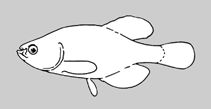Garcialebias bagual (Volcan, Lanés & Gonçalves, 2014)
Hochladen Photos und videos
Pictures | Google BildNo image available for this species;
drawing shows typical species in Rivulidae.
Pictures | Google BildNo image available for this species;
drawing shows typical species in Rivulidae.
Common names from other countries
Klassifizierung / Names Namen | Synonyme | Catalog of Fishes(Gattung, Arten) | ITIS | CoL | WoRMS | Cloffa
> Cyprinodontiformes (Rivulines, killifishes and live bearers) > Rivulidae (Rivulines) > Cynolebiinae
Etymology: Garcialebias: Named for Dr Graciela García and the Greek, 'lebias'; bagual: Bagual refers to an expression used by the Brazilian gaúcho (people living in Rio Grande do Sul State), means a non castrated horse as well as a synonym for being brave, courageous, fearless and audacious; refers to the species having unique adaptations for living in an extreme environment (pond dries up completely during some months of the year) and have been discovered in a remote and isolated area. A name in apposition (Ref. 118216).
Etymology: Garcialebias: Named for Dr Graciela García and the Greek, 'lebias'; bagual: Bagual refers to an expression used by the Brazilian gaúcho (people living in Rio Grande do Sul State), means a non castrated horse as well as a synonym for being brave, courageous, fearless and audacious; refers to the species having unique adaptations for living in an extreme environment (pond dries up completely during some months of the year) and have been discovered in a remote and isolated area. A name in apposition (Ref. 118216).
Environment: milieu / climate zone / depth range / distribution range Ökologie
; süßwasser benthopelagisch; pH range: ? - 5.2. Subtropical
Verbreitung Länder | FAO Gebiete | Ecosystems | Vorkommen | Point map | Einführungen | Faunafri
South America: Currently known only for type locality, in the Encruzilhada do Sul municipality, from a small temporary pond at an altitude of 46 m; associated with the floodplain of the Arroio Abranjo, in the middle course of the Rio Camaquã basin, Laguna dos Patos system, in flat areas surrounded by hills in geomorphological units of the Crystalline Shield of the Rio Grande do Sul State (Ref. 118216).
Size / Gewicht / Alter
Kurzbeschreibung Bestimmungsschlüssel | Morphologie | Morphometrie
Rückenflossenweichstrahlen (insgesamt) : 15 - 23; Afterflossenweichstrahlen: 17 - 25; Wirbelzahl: 28 - 29. Diagnosis: Austrolebias bagual differs from all other species of Austrolebias by the unique colour pattern on the body and dorsal fin in males; usually consists of an overall light brown to dark brown coloration with 3-6 dark grey, narrow vertical bars, bars becoming gradually shorter and fainter towards caudal peduncle (vs. never similar colour patterns); dorsal fin light bluish-green, with 5-7 black vertical bars extending from the base to the medial portion of the fin (vs. absence of a such pattern in the remaining Austrolebias; females lack the pair of black spots arranged vertically in close proximity on the posterior portion of the caudal peduncle, sometimes coalescing to form an 8-shaped blotch, typical of most of the A. adloffi species group (except A. arachan and A. viarius) (Ref. 118216).
Life cycle and mating behavior Geschlechtsreife | Fortpflanzung | Ablaichen | Eier | Fecundity | Larven
Hauptreferenz
Upload your references | Referenzen | Koordinator : Costa, Wilson J.E.M. | Partner
Volcan, M.V., L.E.K. Lanés and A.C. Gonçalves, 2014. Austrolebias bagual, a new species of annual fish (Cyprinodontiformes: Rivulidae) from southern Brazil. aqua, Int. J. Ichthyol. 20(4):161-172. (Ref. 118216)
IUCN Rote Liste Status (Ref. 130435: Version 2024-2)
vom Aussterben bedroht (CR) (B1ab(ii,iii)+2ab(ii,iii)); Date assessed: 28 December 2020
Bedrohung für Menschen
Harmless
Nutzung durch Menschen
Fischereien: nicht kommerziell
FAO(Publication : search) | FishSource |
Mehr Information
Trophic ecology
Nahrungsorganismen
Nahrungszusammensetzung
Nahrungsaufnahme
Food rations
Räuber
Nahrungsorganismen
Nahrungszusammensetzung
Nahrungsaufnahme
Food rations
Räuber
Population dynamics
Growth parameters
Max. ages / sizes
Length-weight rel.
Length-length rel.
Längenhäufigkeiten
Mass conversion
Rekrutierung
Dichte
Growth parameters
Max. ages / sizes
Length-weight rel.
Length-length rel.
Längenhäufigkeiten
Mass conversion
Rekrutierung
Dichte
Life cycle
Fortpflanzung
Geschlechtsreife
Fecundity
Ablaichen
Spawning aggregations
Eier
Eientwicklung
Larven
Larven Pop.Dyn.
Fortpflanzung
Geschlechtsreife
Fecundity
Ablaichen
Spawning aggregations
Eier
Eientwicklung
Larven
Larven Pop.Dyn.
Anatomy
Kiemenoberfläche
Brain
Otolith
Kiemenoberfläche
Brain
Otolith
Physiology
Body composition
Nutrients
Oxygen consumption
Swimming type
Swimming speed
Visual pigments
Fish sound
Diseases & Parasites
Toxicity (LC50s)
Body composition
Nutrients
Oxygen consumption
Swimming type
Swimming speed
Visual pigments
Fish sound
Diseases & Parasites
Toxicity (LC50s)
Genetics
Genetik
Heterozygosity
Vererbbarkeit
Genetik
Heterozygosity
Vererbbarkeit
Human related
Aquaculture systems
Aquakultur Profile
Zuchtlinien
Ciguatera cases
Stamps, coins, misc.
Aquaculture systems
Aquakultur Profile
Zuchtlinien
Ciguatera cases
Stamps, coins, misc.
Tools
E-book | Feldführer | Längenhäufigkeits Tool | Lebensdaten Tool | Punkt Karte | Classification Tree
| Catch-MSY |
Zusatzinformationen
Download XML
Zusammenfassung | Point data | Namen | Photos
Internet Quellen
Aquatic Commons | BHL | Cloffa | Websites from users | FishWatcher Einträge suchen | CISTI | Catalog of Fishes(Gattung, Arten) | DiscoverLife | ECOTOX | Faunafri | Fishtrace | GenBank(Genom, nucleotide) | GloBI | GOBASE | | Google Books | Google Scholar | Google | IGFA World Record | MitoFish | Otolith Atlas of Taiwan Fishes | PubMed | Reef Life Survey | Scirus | SeaLifeBase | Tree of Life | Wikipedia(Gehe zu, Suchen) | World Records Freshwater Fishing | Zoological Record
Estimates based on models
Phylogenetic diversity index (Ref. 82804): PD50 = 0.5000 [Uniqueness, from 0.5 = low to 2.0 = high].
Bayesian length-weight: a=0.00891 (0.00396 - 0.02008), b=3.14 (2.94 - 3.34), in cm Total Length, based on LWR estimates for this (Sub)family-body shape (Ref. 93245).
Trophic level (Ref. 69278): 3.2 ±0.4 se; based on size and trophs of closest relatives
Widerstandsfähigkeit (Ref. 120179): hoch, Verdopplung der Population dauert weniger als 15 Monate. (Preliminary K or Fecundity.).
Fishing Vulnerability (Ref. 59153): Low vulnerability (10 of 100).




